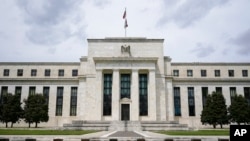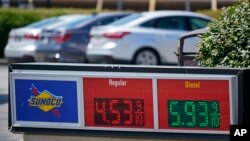The U.S. central bank boosted its benchmark interest rate Wednesday by three-quarters of a percentage point in an ongoing effort to curb soaring consumer prices in the world’s largest economy.
The Federal Reserve rate boost is the second straight .75% hike and pushed its key lending rate to a range of between 2.25% to 2.5%. The Fed is expected to boost it further to 3.4% by the end of 2022, with Fed chairman Jerome Powell saying "another unusually large increase could be appropriate" at the central bank’s September meeting.
The latest rate increase was approved unanimously by the 12-member rate-setting committee even as policy makers acknowledged the U.S. economy is showing signs of slowing.
“Recent indicators of spending and production have softened,” the Fed said. “Nonetheless, job gains have been robust in recent months.”
The Fed is raising rates at its most aggressive pace since the 1980s and now has approved increases at four consecutive policy meetings, starting in March when it approved the first increase from near zero. That’s a level it had kept in place to boost the economy during the coronavirus pandemic.
The higher interest rate is aimed at curbing inflation in the U.S., which in June surged 9.1% year over year, the fastest increase in four decades.
Increases in the Fed’s interest rate reverberate through the U.S. economy, with higher borrowing costs for businesses and for car loans and consumer goods. By making it costlier to borrow money, the Fed’s expectation is that consumers and businesses will cut their spending and thus help curb inflation.
Higher-than-expected inflation has hit the U.S. and European economies, squeezing family budgets, with the higher costs of goods often outpacing wage gains for workers. The European Central Bank raised its key lending rate by a half percentage point last week, its first increase in 11 years.
Even as inflation worries businesses and consumers, the International Monetary Fund said Tuesday that world economic growth is slowing and the prospects for a quick recovery are gloomy.
The IMF said it expects growth to slow from last year’s 6.1% advance across the globe to 3.2% this year, four-tenths of a percentage point lower than it forecast in April.
“A tentative recovery in 2021 has been followed by increasingly gloomy developments in 2022 as risks began to materialize,” the IMF said. “Global output contracted in the second quarter of this year, owing to downturns in China and Russia, while U.S. consumer spending undershot expectations.”
The Washington-based international finance agency said that in addition to inflationary pressures, “several shocks have hit a world economy already weakened by the pandemic,” including “a worse-than-anticipated slowdown in China, reflecting COVID-19 outbreaks and lockdowns, and further negative spillovers from [Russia’s] war in Ukraine.”
The IMF said the price of consumer goods, especially for food and energy, is increasing throughout the world. The cost is expected to rise by 6.6% in advanced economies this year and by 9.5% in emerging-market and developing economies, with both figures up nearly a percentage point from an IMF projection earlier this year.
“The risks to the outlook are overwhelmingly tilted to the downside,” the IMF said.
The Federal Reserve rate boost is the second straight .75% hike and pushed its key lending rate to a range of between 2.25% to 2.5%. The Fed is expected to boost it further to 3.4% by the end of 2022, with Fed chairman Jerome Powell saying "another unusually large increase could be appropriate" at the central bank’s September meeting.
The latest rate increase was approved unanimously by the 12-member rate-setting committee even as policy makers acknowledged the U.S. economy is showing signs of slowing.
“Recent indicators of spending and production have softened,” the Fed said. “Nonetheless, job gains have been robust in recent months.”
The Fed is raising rates at its most aggressive pace since the 1980s and now has approved increases at four consecutive policy meetings, starting in March when it approved the first increase from near zero. That’s a level it had kept in place to boost the economy during the coronavirus pandemic.
The higher interest rate is aimed at curbing inflation in the U.S., which in June surged 9.1% year over year, the fastest increase in four decades.
Increases in the Fed’s interest rate reverberate through the U.S. economy, with higher borrowing costs for businesses and for car loans and consumer goods. By making it costlier to borrow money, the Fed’s expectation is that consumers and businesses will cut their spending and thus help curb inflation.
Higher-than-expected inflation has hit the U.S. and European economies, squeezing family budgets, with the higher costs of goods often outpacing wage gains for workers. The European Central Bank raised its key lending rate by a half percentage point last week, its first increase in 11 years.
Even as inflation worries businesses and consumers, the International Monetary Fund said Tuesday that world economic growth is slowing and the prospects for a quick recovery are gloomy.
The IMF said it expects growth to slow from last year’s 6.1% advance across the globe to 3.2% this year, four-tenths of a percentage point lower than it forecast in April.
“A tentative recovery in 2021 has been followed by increasingly gloomy developments in 2022 as risks began to materialize,” the IMF said. “Global output contracted in the second quarter of this year, owing to downturns in China and Russia, while U.S. consumer spending undershot expectations.”
The Washington-based international finance agency said that in addition to inflationary pressures, “several shocks have hit a world economy already weakened by the pandemic,” including “a worse-than-anticipated slowdown in China, reflecting COVID-19 outbreaks and lockdowns, and further negative spillovers from [Russia’s] war in Ukraine.”
The IMF said the price of consumer goods, especially for food and energy, is increasing throughout the world. The cost is expected to rise by 6.6% in advanced economies this year and by 9.5% in emerging-market and developing economies, with both figures up nearly a percentage point from an IMF projection earlier this year.
“The risks to the outlook are overwhelmingly tilted to the downside,” the IMF said.











